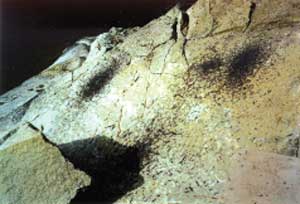 Privacy
| Legal Privacy
| Legal |
Table
of Contents Back | Next | Home | Cover Page |
Technology & Development Center |
Asphalt Paving of Treated Timber Bridge Decks
Another Forest Service bridge, crossing the Little North Fork of the Santiam River, showed a puzzling pattern of membrane dripping. The Shady Cove Bridge (figure 23) was constructed in 1991. The deck is longitudinal glued-laminated timber panels treated with pentachlorophenol in a type C light oil solvent. The deck was sealed with a primer before the rubberized paving membrane and asphalt overlay were installed. Some paving difficulties were experienced, but the deck was relatively tight with no apparent asphalt dripping for almost 9 years. In the spring of 2000, rubberized asphalt began dripping from the bridge (figure 24a). The asphalt that has dripped onto the bedrock under the bridge clearly reveals the location of the deck panel joints above (figure 24b).

Figure 23—Asphalt leaching to the pavement surface
of Shady Cove Bridge near Eugene, OR.

Figure 24a—Rubberized asphalt dripping from the
underside of the Shady Cove Bridge.

Figure 24b—Asphalt dripping onto rocks under
the Shady Cove Bridge.
Asphalt bled to the pavement surface, forming pools about 6 inches in diameter. Forest personnel cut out a 12-inch-square piece of asphalt pavement. The bottom 1 inch of the 2-inch-thick pavement was semiliquid.
The summer of 2000 was an abnormally warm summer that followed a very dry, warm winter. Perhaps the weather contributed to the asphalt bleeding observed that summer. Most of the bridges were treated with preservatives carried in heavy oil solvents. But the Shady Cove Bridge, probably the most extreme case of asphalt bleeding, was treated with penta in a light oil solvent. Both the light and heavy oil solvents were dissolving asphalt in the paving membranes, and possibly dissolving asphalt from the pavements.
To validate whether preservative treatment dissolved paving membranes, several tests were conducted on three different paving membranes. The membranes were submerged in four solutions:
All the solvents and solutions dissolved all of the asphalt in the paving membranes within 3 days.
The residual light-oil-only and heavy-oil-only solutions contained finely ground rubber particles from the membranes. The residual penta and copper naphthenate light oil solutions appeared to have dissolved the rubber particles as well as the asphalt material.
Solvents leach from the treated timber members and merge with the asphalt when heat is supplied by the sun or by application of hot asphalt pavement. This leaching dissolves priming or tack materials recommended by membrane and fabric manufacturers.
Engineers in the Nicolet and Chequamegon National Forests in Wisconsin (Johnson 1987 and Faurot 1984) experienced good results with rubberized membranes on treated timber decks by waiting about 2 years before placing the membrane and paving. The preservative solvents evaporated or were removed by traffic. Preparation for paving included thorough cleaning with shovels, brushes, and compressed air before applying the membrane and pavement. A light tack coat was used.
In most cases, paving membranes should not be placed directly against treated wood. They can be used over a base layer of asphalt. A crowned 1 ½- to 2-inch layer of asphalt should be placed directly onto the treated timber bridge deck. The paving membrane is applied and a final 1 ½- to 2-inch layer of asphalt is placed over the membrane (Weyers, Loferski, Dolan, Haramis, Howard, and Hislop 2001). This is a thicker asphalt pavement wearing surface than typically is used on a bridge deck. The bridge design must include this additional weight, which is higher than normally anticipated.
Deck Preparation—A properly prepared deck can add measurably to the success of an asphalt application. The Forest Service publication Timber Bridges: Design, Construction, Inspection, and Maintenance (Ritter 1990) outlines a number of steps to successful asphalt paving:
Spreading sand (blotter) on the deck and removing it after about a week helps to absorb excess preservatives before asphalt pavement or a liquid asphalt tack coat is applied.
Existing decks can be repaved to stop ongoing problems. The pavement can be removed using heavy equipment and then scraped. Excess preservatives can be absorbed by a sand blotter before cleaning the deck and placing a new layer of asphalt. If additional preservative solvent bleeding is anticipated, a dry, nonwoven paving fabric can be stapled to the deck before it is paved.